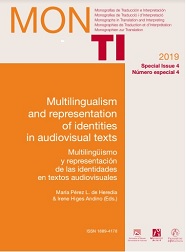What’s cooking in multicultural films? Food, language and identity in British and American audiovisual products and their Italian dubbed version
Main Article Content
Abstract
Downloads
Article Details
The documents contained in these directories are included by the contributing authors as a means to ensure timely dissemination of scholarly and technical work on a non-commercial basis. It is understood that all persons copying this information will adhere to the terms and constraints invoked by each author's copyright. These works may not be reposted without the explicit permission of the copyright holder.
References
Anchimbe, Eric A. (ed.) (2014) Structural and Sociolinguistic Perspectives on Indigenisation: On Multilingualism and Language Evolution. London & New York: Springer.
Auer, Peter & Li Wei (eds.) (2007) Handbook of Multilingualism and Multilingual Communication. Berlin: Mouton de Gruyter.
Auer, Peter & Li Wei (eds.) (2005) “A postscript: code-switching and social identity.” Journal of Pragmatics 37, pp. 403-410.
Bhatia, Tej K. & William C. Ritchie (eds.) (2012) The Handbook of Bilingualism and Multilingualism. Oxford: Blackwell.
Bleichenbacher, Lukas. (2008) Multilingualism in the Movies: Hollywood Characters and their Language Choices. Tübingen: Francke.
Bower, Anne L. (2004) Reel Food. Essays on Food and Film. London & New York: Routledge.
Bucholtz, Mary & Kira Hall. (2005) “Identity and interaction: a socio-cultural linguistic approach.” Discourse Studies VII:4-5, pp. 586-614.
Carter, Ronald. (2004) Language and Creativity: the Art of Common Talk. London & New York: Routledge.
Chaume, Frederic. (2004) “Film Studies and Translation Studies: two disciplines at stake in Audiovisual Translation.” Meta 49:1, pp. 12-24.
Chiaro, Delia. (2009) “Issues in audiovisual translation.” In: Munday, Jeremy (ed.) 2009. The Routledge Companion to Translation Studies. London & New York: Routledge, pp. 141-165.
Díaz Cintas, Jorge & Aline Remael (eds.) (2007) Audiovisual Translation: Subtitling. Manchester: St Jerome.
Dries, Josephine. (1995) Dubbing and Subtitling. Guidelines for Production and Distribution. Düsseldorf: European Institute for the Media.
Edwards, John. (2012) Multilingualism: Understanding Linguistic Diversity. London: Continuum.
Gottlieb, Henrik. (2009) “Subtitling against the current: Danish concepts, English Minds.” In: Díaz Cintas, Jorge (ed.) 2009. New Trends in Audiovisual Translation. Clevedon & Philadelphia: Multilingual Matters, pp. 21-43.
Gumperz, John. (1982) Discourse Strategies. Cambridge: Cambridge University Press.
Ivir, Vladimir. (1987) “Procedures and strategies for the translation of culture.” Indian Journal of Applied Linguistic 13:2, pp. 35-46.
Kelly-Holmes, Helen & Tommaso M. Milani (eds.) (2013) Thematising Multilingualism in the Media. Amsterdam & Philadelphia: John Benjamins.
Leppihalme, Ritva. (2011) “Realia.” In: Gambier, Yves & Carol Myers-Scotton (eds.) 2011. Handbook of Translations Studies. Amsterdam & Philadelphia: John Benjamins.
Myers-Scotton, Carol. (1993) Social Motivations for Code-switching. Oxford: Clarendon.
Newmark, Peter. (1988) A Textbook of Translation. New York: Phoenix ELT.
Pavesi, Maria. (2009) “Dubbing English into Italian: A closer look at the translation of spoken language.” In: Díaz-Cintas, Jorge (ed.) 2009. New Trends in Audiovisual Translation. Clevedon & Philadelphia: Multilingual Matters, pp. 201-213.
Pedersen, Jan. (2005) “How is culture rendered in subtitles?” In: MuTra 2005 – Challenges of Multidimensional Translation: Conference Proceedings. Electronic version: www.euroconferences.info/proceedings/2005_Proceedings/2005_ Pedersen_Jan.pdf
Ranzato, Irene. (2016) Translating Culture Specific References on Television: The Case of Dubbing. London & New York: Routledge.
Siemund, Peter; Ingrid Gogolin; Monika Edith Schulz & Julia Davydova (eds.) (2013) Multilingualism and Language Diversity in Urban Areas: Acquisition, Identities, Space, Education. Amsterdam & Philadelphia: John Benjamins.
Snell-Hornby, Mary. (1995) Translation Studies: An Integrated Approach. Amsterdam & Philadelphia: John Benjamins.
Ulrych, Margherita. (2000) “Locating Universal Features of Translation Behaviour through Multimedia Translation Studies.” In: Bollettieri Bosinelli, Rosa Maria et al. (eds.) 2000. La traduzione multimediale: quale traduzione per quale testo? Bologna: CLUEB, pp. 407-429.
Venuti, Lawrence. (1998) The Scandals of Translation: Towards an Ethics of Difference. London & New York: Routledge.
Vinay, Jean-Paul & Jean Darbelnet. (1958) Stylistique comparée du français et de l’anglais. Paris: Didier.
Vinay, Jean-Paul & Jean Darbelnet. (2002) “A methodology for translation.” In: Venuti, Lawrence (ed.) 2002. The Translation Studies Reader. London & New York: Routledge, pp. 128-137.
Wei, Li. (2011) “Moment analysis and translanguaging space: discursive construction of identities in multilingual Chinese youth in Britain.” Journal of Pragmatics 43, pp. 1222-1235.
Filmography:
Ae Fond Kiss (Ken Loach 2004)
Bend it Like Beckham (Gurinder Chadha 2002)
Eat Pray Love (Ryan Murphy 2010)
My Big Fat Greek Wedding (Joel Zwick 2002)
My Big Fat Greek Wedding 2 (Kirk Jones 2016)
My Life In Ruins (Donald Petrie 2009)
The Hundred-Foot Journey (Lasse Hallström 2014)
The Mistress of Spices (Paul Mayeda Berges 2008)


